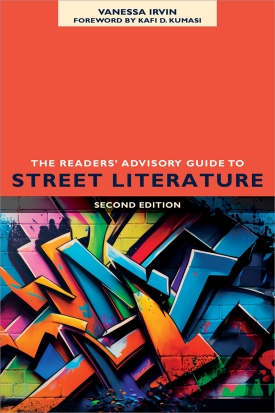Primary tabs
You don't need to be an ALA Member to purchase from the ALA Store, but you'll be asked to create an online account/profile during the checkout to proceed. This Web Account is for both Members and non-Members.
If you are Tax-Exempt, please verify that your account is currently set up as exempt before placing your order, as our new fulfillment center will need current documentation. Learn how to verify here.
- Description
- Table of Contents
- About the author
- Reviews
Foreword by Kafi D. Kumasi
Building on the continued popularity of street lit, Irvin's updated guide will help library workers, teachers, and other community-based educators encourage reading and library use by meeting patrons' reading interests and information needs.
Street lit, also known as urban fiction, addresses with unflinching grit the concerns and problems of city living and survival in the United States. As a leisure reading genre, street lit encompasses some of the most in-demand titles in American public libraries’ collections. In this new, thoroughly revised edition of her popular guide, Irvin’s coverage of street lit is fortified by professional narratives from her experiences as a public librarian in Philadelphia, an updated treatment of canonical and contemporary book titles, and scholarly references that reflect her research background in library and information science. Attuned to the needs of novices and devotees alike, Irvin
- sketches out the rich history of the urban fiction, showing why it appeals so strongly to readers and providing a quick way for street lit novices to get up to speed on understanding the genre;
- demonstrates why promoting street lit means promoting literacy;
- explores how authors, readers, and librarians read and respond to the genre and one another;
- covers a variety of subgenres in terms of scope, popularity, style, major authors, and works;
- shares approaches to readers’ advisory (RA) founded on creating trust between the patron and the librarian; and
- offers pointers on collection development and library programming.
Series Introduction by Joyce Saricks and Neal Wyatt
Foreword by Kafi D. Kumasi
Introduction: The Canonical Agency of Street Lit
Chapter 1: History of Street Literature in American Culture
Chapter 2: Characteristics of Street Lit
Chapter 3: Understanding, Classifying, and Defining Street Lit
Chapter 4: Readers’ Advisory Approaches to Street Lit
Chapter 5: Collection Management Considerations for Street Lit
Chapter 6: Library Programming for Street Lit
Chapter 7: Reading Street Lit as a Literacy Practice
Epilogue: Street Lit’s Enduring Legacy
Appendix: Street/Urban Literature: A Foundational Collection
References
Index
Vanessa Irvin
Vanessa Irvin is an Associate Professor of Library Science at East Carolina University, Greenville, North Carolina. With a frontline librarian career spanning over four decades, Dr. Irvin teaches reference and information services, public libraries, and reading response theory for librarians. Vanessa's research focuses on integrating cultural heritage methodologies with librarians' work practices for professional learning and development.
Praise for the first edition
"In this comprehensive book, Morris provides excellent input to aid in collection development and includes a list of publishers."
— School Library Journal
"Morris persuasively overturns common prejudices against Street Literature, situating the genre convincingly in a long literary history of narratives located in low-income city neighborhoods. Her broadened conceptualization of the genre provides educators with indispensable tools for linking Street Literature with works of other literary periods and genres, non-fiction formats and even audiovisual media. Librarians and teachers will gain in-depth knowledge about readers’ agency, tastes and complex reading practices—all essential prerequisites for engaging seriously with street literature and its readers."
— Kristina Graaff, author of Street Literature: Black Popular Fiction in the Era of U.S. Mass Incarceration and Junior Faculty, Humboldt University Berlin



